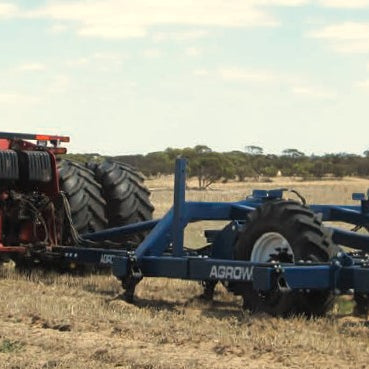
ALL STATES & TERRITORIES

Initial investigations looked at the impact of different shanks, working speeds, inclusion plate dimensions and additional components to assess soil inclusion. Determining their maximum efficiency; maximising the volume of soil loosened and incorporated while controlling the depth of the incorporation to a targeted layer if needed are the aims. Along with this, trying to minimise impacts on drawbar requirements.
Agrowplow’s own evidence shows there is a market to expand deep ripping technology, especially where topsoil inclusion can be achieved successfully, reliably and economically by taking experiments from the program to market.
One of the key implements for the project was a custom-built Agrowplow deep ripper frame, loosely based on the AP31 The frame was made of 150x150x9mm RHS steel and fitted out with Agrowplow’s #9 shank assemblies and inclusion plates.
The Uni SA team, led by Jacky Desbiolles and Chris Saunders, have worked on similar research projects in sandy soils over the last five years and carried out many investigations in South Australia and Victoria, with the aim to study inclusion performance on soil amelioration.
“This research has advanced our understanding of the mechanics of many soil amelioration machines including ripping with inclusion plates for improved soil amelioration techniques and increased productivity,” Dr Saunders said.
The most recent tests carried out near Bute (SA) included experimenting with frame accessories including inclusion discs, different inclusion plate models (UniSA custom design), as well as a bar roller to investigate both an increased volume of included material and to leave the paddock in a seeder ready condition after the ripping with inclusion.,
The team has several preliminary conclusions from their fieldwork in sandy soils. These conclusions are ready to be validated for the performance of crop establishment in ripped soils and benefit in crop responses.
The aim will be to secure more project funding from the Grain Research and Development Corporation (GRDC) as their research progresses to the next stage. They will be testing their conclusions on shank spacing, inclusion plate sizes and lengths with a range of additional incorporation and surface finishing tool at a range of speeds.
“There’s a range of farmer experiences out there. We’re in a stage where we can change that,” Dr Desbiolles said. “We can modify practices according to what the optimum should be, as dictated by agronomic requirements. Then we would have a system that’s much more holistic where the machine does the job required and leaves a finish that is ready for seeding.”
Agrowplow is assessing the trial results as part of the wider deep ripper range review. It’s hoped the depth of knowledge gained from the research will lead to improved efficiency and performance gains when the latest models are released.
“Our goal has always been continuous innovation,” says Davimac Group Managing Director Cameron Provost.
“The partnership with the University of South Australia has shown to be a great addition to our own product enhancement strategy. We’re proud our offer is able to give back by advancing understanding of deep ripping practices.”
Read more about the GRDC's recommendations for deep ripping in sandy soils.


